The Nikon F2, introduced in the 1970s, is a mechanical, manual-focus SLR camera renowned for its durability, reliability, and interchangeable viewfinders. Its robust design and compatibility with a wide range of Nikkor lenses made it a favorite among professionals and photography enthusiasts. This iconic camera exemplifies Nikon’s commitment to craftsmanship and versatility, offering unparalleled control over photographic settings. Its enduring popularity underscores its status as a timeless tool in the world of film photography.
Overview of the Nikon F2 Camera
The Nikon F2 is a mechanical, manual-focus SLR camera introduced in the 1970s, known for its rugged design and reliability. It features interchangeable viewfinders and screens, offering flexibility for various shooting needs. Built with precision engineering, the F2 supports a wide range of Nikkor lenses and accessories, making it a versatile tool for professionals and enthusiasts. Its mechanical operation ensures dependability without reliance on batteries, while its manual controls provide precise creative control over exposures.
Historical Significance of the Nikon F2
The Nikon F2, introduced in the 1970s, holds a significant place in photography history as Nikon’s flagship manual-focus SLR. Its reputation for reliability and durability made it a favorite among professionals. The F2’s design laid the foundation for future Nikon models, emphasizing modularity with interchangeable viewfinders and screens. Its compatibility with a vast range of Nikkor lenses solidified its status as a versatile and enduring tool in the evolution of film photography.

Key Features and Specifications
The Nikon F2 is a mechanical SLR from the 1970s, featuring manual focus, interchangeable viewfinders, and compatibility with a wide range of Nikkor lenses.
Design and Build Quality

The Nikon F2 boasts a robust, all-mechanical design with a solid brass body, ensuring exceptional durability. Its titanium shutter curtain guarantees reliability up to 1/2000th of a second. The camera’s modular design allows for interchangeable viewfinders and focusing screens, catering to diverse shooting needs. Built to withstand heavy use, the F2 is a testament to Nikon’s commitment to craftsmanship, making it a trusted companion for professionals and enthusiasts alike.
Shutter Speed and Metering System
The Nikon F2 features a titanium shutter curtain with speeds from 1/2000th of a second to 1 second, plus a bulb mode for extended exposures. Its center-weighted metering system, powered by a CdS cell, provides accurate exposure readings. The camera supports manual control, allowing photographers to adjust settings precisely. When paired with Nikkor lenses, the F2 ensures optimal performance. The optional EE aperture control attachment enables aperture-priority mode, enhancing creative control over exposures.
Viewfinder and Focusing Aids
The Nikon F2 offers interchangeable viewfinders, including the FE-2 eye-level finder and DA-2 action finder, providing bright, clear views for precise composition. Its viewfinder features a built-in microprism focusing screen for accurate manual focusing. Optional viewfinder screens, such as those with grid lines or high-magnification eyepieces, enhance customization. The camera’s robust design ensures durability, while the focusing aids simplify achieving sharp images, making it a versatile tool for photographers seeking precision and control in their work.
Manual Operation Basics
The Nikon F2 operates entirely mechanically, relying on manual controls for aperture, shutter speed, and focus. This design ensures reliability without battery dependency, emphasizing hands-on photography skills.
Loading Film in the Nikon F2
Loading film in the Nikon F2 involves opening the camera back using the O/C key, aligning the film leader with the red mark, and securing it to the spool. Gently wind the film using the crank until it reaches the end. Close the back, advance to the first blank shot, and set the ISO. This mechanical process ensures reliable film handling, emphasizing the camera’s manual operation and durable design.
Setting the Correct ISO
Setting the correct ISO on the Nikon F2 is essential for accurate exposure. Locate the ISO dial on the camera’s left side and align it with the film’s speed rating (e.g., 400 or 100). Ensure the dial clicks firmly into place. After setting, advance the film to the first frame to ensure proper metering. Correct ISO alignment is crucial for optimal image quality, preventing under or overexposure. Always verify the ISO matches your film speed for consistent results.
Understanding Aperture and Shutter Speed
Aperture and shutter speed are fundamental to controlling exposure on the Nikon F2. Aperture, measured in f-stops, regulates light entry and depth of field. Lower f-stops (e.g., f/2.8) allow more light and blur backgrounds, while higher stops (e.g., f/16) sharpen more of the image. Shutter speed, in seconds or fractions, controls motion capture and light duration. Faster speeds freeze action, while slower speeds create motion blur. Balancing these ensures desired creative effects and proper exposure. Always experiment to achieve your vision.
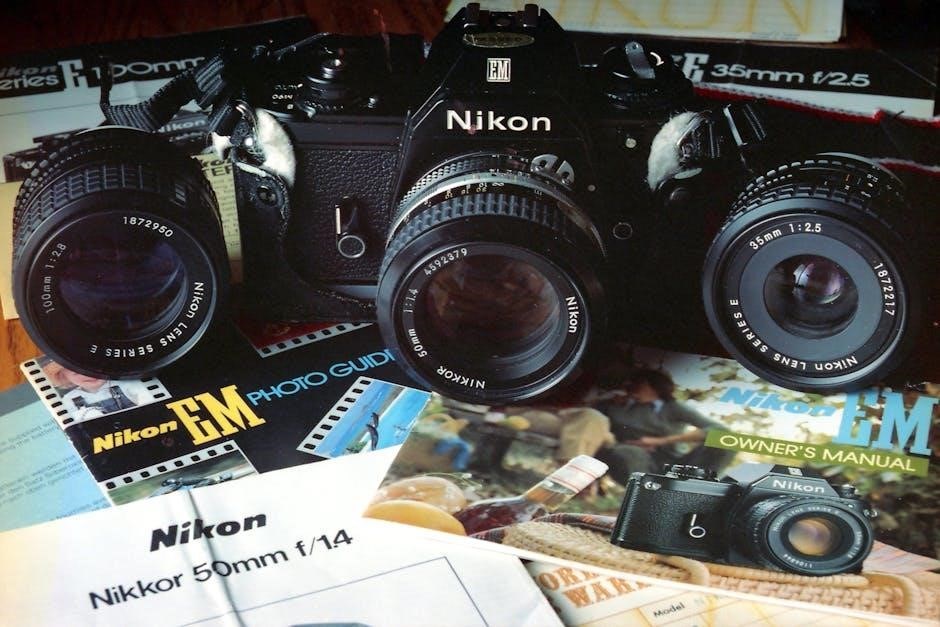
Focusing Techniques
The Nikon F2 excels in manual focusing, offering precise control through its robust mechanical design. Use the built-in focusing aids, such as the microprism screen, for sharp results.
Using the Built-in Light Meter
The Nikon F2 features a center-weighted light meter, providing accurate exposure readings. To use it, set the ISO on the camera and adjust aperture or shutter speed until the needle aligns with the center mark. This ensures balanced exposure for your shots. The meter is reliable under various lighting conditions, making it an essential tool for precise film photography.
Manual Focusing with Precision
The Nikon F2 allows for precise manual focusing through its interchangeable viewfinders and screens. The camera’s clear viewfinder and optional split-image or microprism screens enable photographers to achieve sharp focus effortlessly. The focus ring operates smoothly, offering tactile feedback for fine adjustments. This mechanical system ensures complete control over focus, making it ideal for photographers who value precision and manual operation in their creative process.
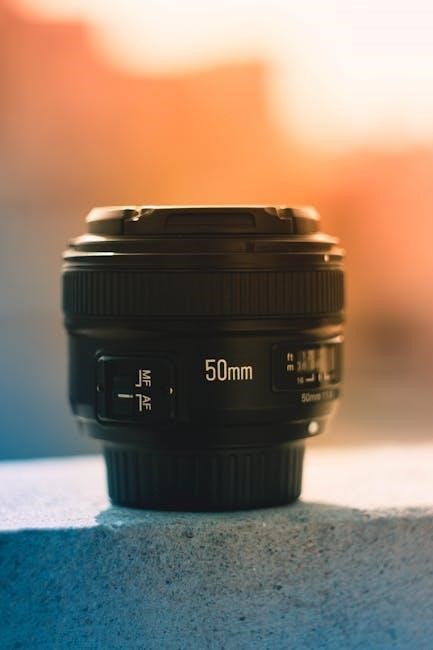
Exposure and Metering
The Nikon F2 features a center-weighted metering system for precise exposure control. It effectively handles various lighting conditions, including backlight, ensuring balanced exposures with minimal adjustments and accuracy.
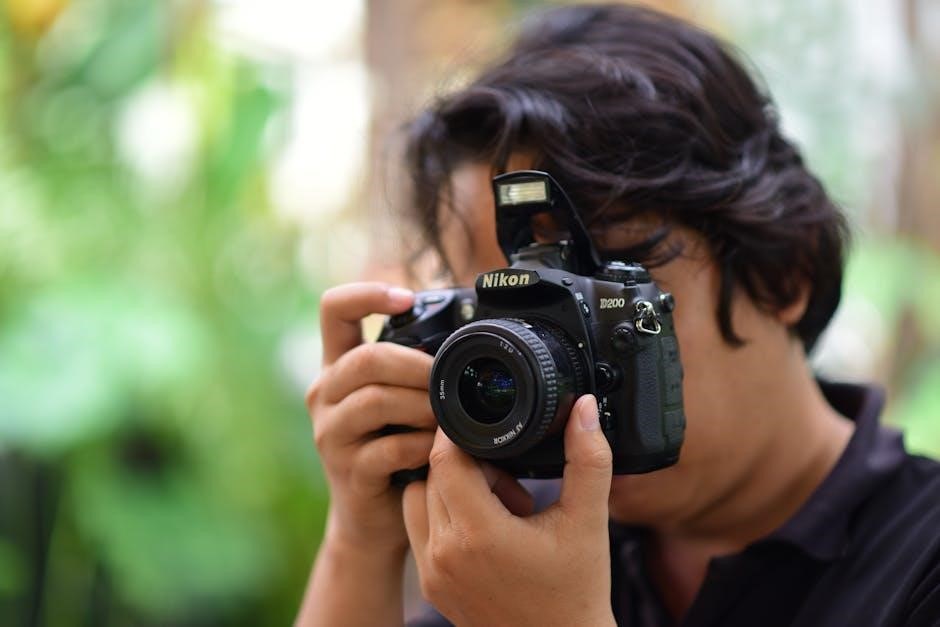
Center-Weighted Metering Explained
The Nikon F2 employs a center-weighted metering system, emphasizing the central 12mm area of the frame. This method ensures balanced exposures by prioritizing the subject’s mid-tone values, reducing overexposure risks in high-contrast scenes. It adjusts aperture and shutter speed to maintain optimal lighting, making it ideal for portraits and everyday photography. The system’s simplicity and effectiveness contribute to the F2’s reputation as a reliable manual camera.
Compensating for Backlight
When shooting with the Nikon F2 in backlit conditions, manual adjustments are crucial. Use the center-weighted meter to gauge light, then compensate by adjusting aperture or shutter speed. For accurate results, overexpose by 1-2 stops to ensure the subject isn’t underexposed. Bracketing shots or using a lens hood can also help manage harsh backlight, preserving detail in both highlights and shadows for well-balanced exposures.
Accessories for Enhanced Functionality
The Nikon F2 supports a range of accessories, including interchangeable viewfinders, focusing screens, and the MB-15 battery grip, enhancing its versatility for various photographic needs and preferences.
Optional Finders and Screens
The Nikon F2 offers interchangeable viewfinders, such as the iconic Photomic and Speedotron models, for enhanced brightness and metering accuracy. Additional focusing screens, including plain, grid, and high-magnification options, cater to specific shooting needs, improving composition and focus precision. These accessories allow photographers to customize their workflow, ensuring optimal performance in diverse lighting and subject conditions, while maintaining the camera’s legendary reliability and adaptability.
The MB-15 Battery Grip
The MB-15 Battery Grip is a specialized accessory designed for the Nikon F2, offering extended battery life and enhanced ergonomics. It allows seamless compatibility with additional power sources, ensuring uninterrupted shooting sessions. The grip is crafted to match the F2’s build quality, providing a secure and comfortable hold. This accessory is particularly useful for photographers requiring prolonged use in demanding environments, maintaining the camera’s operational efficiency without compromising its renowned durability and reliability.
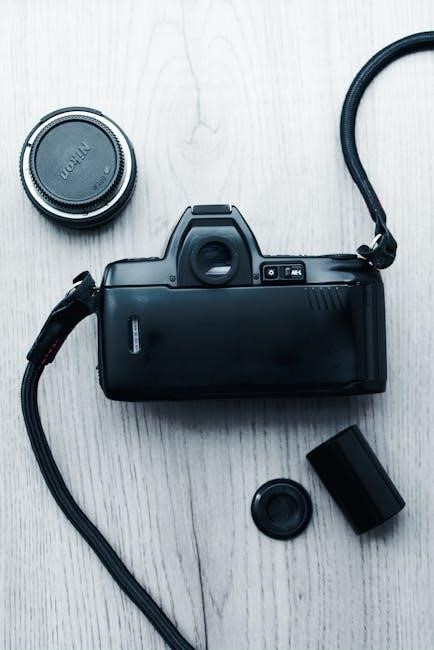
Maintenance and Care
Regular maintenance ensures the Nikon F2’s longevity and optimal performance. Clean the viewfinder and mirror frequently to prevent dust buildup. Store the camera in a dry, cool place to avoid moisture damage. Avoid harsh chemicals and extreme temperatures. Follow the manual’s care instructions for proper handling and preservation of this iconic camera.
Cleaning the Viewfinder and Mirror
Cleaning the Nikon F2’s viewfinder and mirror is essential for maintaining clarity. Use a soft, dry cloth to gently remove dust and smudges. Avoid harsh chemicals or abrasive materials that could scratch the surfaces. For stubborn spots, lightly dampen the cloth with distilled water, but ensure no moisture remains. Regular cleaning prevents debris from affecting image composition and focus accuracy, ensuring optimal performance for years to come.
Lubricating Mechanical Components
Regular lubrication of the Nikon F2’s mechanical components ensures smooth operation. Use high-quality grease on gears and pivots, avoiding excessive application; The shutter curtains and mirror mechanism benefit from light lubrication to maintain precise movement. Never use oil or inappropriate substances, as they may attract dust or degrade over time. Proper lubrication preserves the camera’s functionality and longevity, ensuring reliable performance for decades of use.


Nikon F2 Lens System
The Nikon F2 supports a wide range of Nikkor lenses, including fisheye, wide-angle, standard, and telephoto options. Its F-mount compatibility ensures versatility, catering to diverse photography needs.
Compatible Nikkor Lenses
The Nikon F2 is compatible with a vast array of Nikkor lenses, including fisheye, wide-angle, standard, and telephoto options. Its F-mount system ensures compatibility with lenses like the 24mm f/2, 35mm f/2, and 50mm f/1.4, among others. This versatility allows photographers to adapt to various shooting scenarios, from landscape to portrait photography. The F2’s interchangeable lens system is a cornerstone of its enduring appeal, making it a versatile tool for both professionals and enthusiasts alike.
Specialty Lenses for Unique Effects
The Nikon F2 supports a range of specialty Nikkor lenses for unique effects, such as the 24mm f/2.8 for wide-angle shots and the 35mm f/1.4 for shallow depth of field. Ultrawide lenses like the 13mm f/5.6 and fisheye options provide extreme perspectives, while telephoto lenses like the 1000mm Reflex enable distant subject capture. These lenses expand creative possibilities, offering photographers diverse tools to achieve distinctive visual results in various genres of film photography.
Troubleshooting Common Issues
Common issues with the Nikon F2 include shutter curtain problems, which can cause light leaks, and meter malfunctions, requiring battery checks and ISO adjustments for accurate exposures.
Shutter Curtain Problems
The Nikon F2’s shutter curtains can experience tears or misalignment, leading to light leaks and uneven exposures. Regular inspection and cleaning with a soft swab can prevent damage. If issues arise, professional repair is recommended to replace worn or damaged curtains. Ensuring the shutter is wound correctly and avoiding extreme temperatures can also prevent such problems, maintaining the camera’s reliability and performance over time.
Meter Malfunction Solutions
If the Nikon F2’s light meter malfunctions, ensure the battery is fresh and correctly installed. Clean the meter’s contacts with a soft cloth to remove oxidation. If issues persist, recalibrate the meter or replace it. Professional servicing may be necessary for severe cases. Always refer to the manual for precise troubleshooting steps to maintain accurate exposures and optimal camera functionality over years of use.
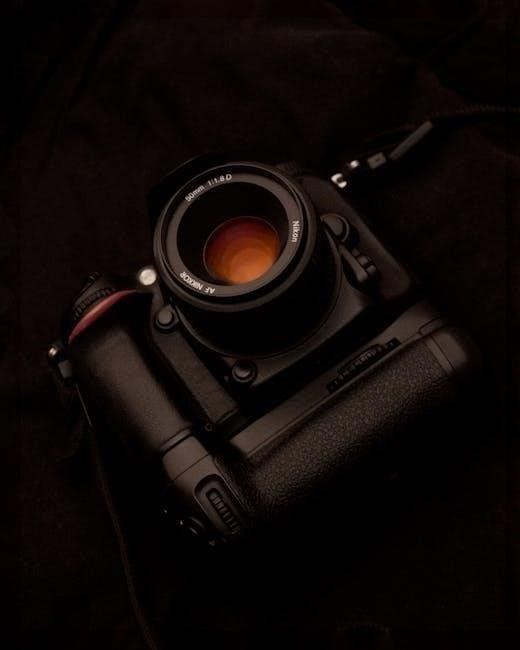
Comparing the Nikon F2 to Other Models
The Nikon F2 stands as a mechanical flagship within Nikon’s iconic F series, celebrated for its reliability and interchangeable accessories, bridging the gap between earlier and advanced models.
vs. Nikon F3
The Nikon F2 and F3 share a similar lineage but differ in functionality. The F2 is fully mechanical, relying on manual operation, while the F3 introduced electronic shutter control and required batteries. The F3 added features like aperture-priority mode, appealing to those seeking modern convenience. However, the F2’s mechanical simplicity and compatibility with older Nikkor lenses make it a preferred choice for purists and collectors, emphasizing tactile photography experiences.
vs. Nikon FM2
The Nikon FM2, introduced later than the F2, features a more compact design and advanced metering capabilities. Unlike the F2, the FM2 incorporates an electronic shutter and offers aperture-priority mode, enhancing ease of use. However, the F2 boasts a more extensive system of interchangeable viewfinders and screens, catering to professional needs. Both cameras excel in durability, but the FM2’s modern features make it a bridge between manual and automatic photography, while the F2 remains a mechanical masterpiece for purists.
The Nikon F2 stands as a testament to timeless design and functionality, offering precise manual control and durability. Its enduring appeal lies in its mechanical simplicity and professional-grade performance, making it a cherished tool for film photography enthusiasts and a landmark in Nikon’s legacy.
Final Thoughts on the Nikon F2
The Nikon F2 is a legendary camera celebrated for its reliability, mechanical precision, and timeless design. Its manual operation and interchangeable viewfinders cater to professionals seeking ultimate control. With a vast system of Nikkor lenses, the F2 delivers exceptional versatility. Photographers praise its intuitive controls and professional-grade performance. As a testament to Nikon’s engineering, the F2 remains a cherished tool for film enthusiasts, offering enduring satisfaction and creative freedom.